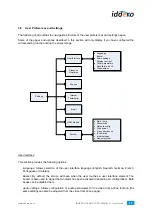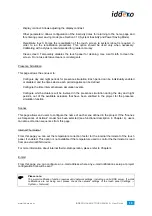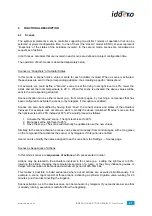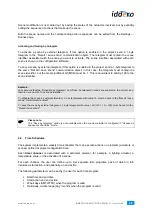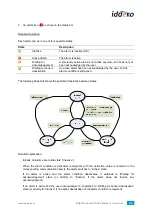
www.iddero.com
IDDERO HCx-KNX TOUCH PANELS – User Guide
29
(“Discard new input events”), or to discard the operation in progress and immediately start processing
any new telegrams received (“Replace pending output events”).
Example:
Let’s assume we set a delay unit with a delay of 10 minutes.
At 18:00 a telegram with “value1” is received.
At 18:05 a telegram with “value2” is received.
The result depends on the setting of the “Event overlapping” parameter:
If set to “Discard new input events”, the “value2” telegram will be discarded, and at 18:10 the delay unit
will send the “value1” telegram.
If set to “Replace pending output events”, the “value1” telegram will be discarded, and at 18:15 the
delay unit will send the “value2” telegram.
As in other logic functions, delay units include a disabling object (L) which allows to temporarily inhibit
the element’s function.
When the delay unit is disabled, it does not generate new values at its output, and it does not accept
new events at its input; however, if there was a delay in progress when disabled, this delay will not be
cancelled.
Once re-enabled, if a delay was completed during the disabling time, the corresponding value will be
sent out. Otherwise, the “Transmit when function re-enabled” parameter will determine whether the
last value that was generated before disabling should be retransmitted.
Comparators
Comparators are elements that compare two numeric values at their inputs, A and B, and update their
(binary) output depending on the result of the operation. The actual condition to check can be
configured (A > B, A
≥
B, A = B), along with the actions to be taken when the condition is fulfilled and
when it is not fulfilled.
Comparators can be used with all numeric KNX data types (both integers and floats).
In order to better understand the operation of comparators, it is important to consider the concepts of
hysteresis and tolerance.
The
tolerance
parameter is only applied in equality comparators (A = B). It represents the maximum
distance that should exist between A and B so that it can be interpreted that the equality condition
begins to be fulfilled. That is, the condition is fulfilled if (|A – B|
≤
tolerance)
The
hysteresis
parameter represents the minimum distance that should exist between A and B, once
the comparison condition is fulfilled, so that it can be detected that the mentioned condition is no
longer fulfilled. This parameter is designed to avoid quick changes in the comparator output when both
inputs take very similar values:



